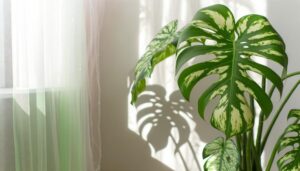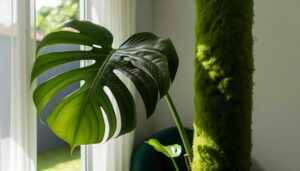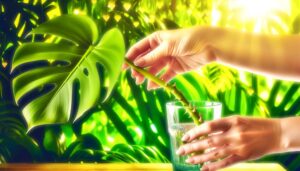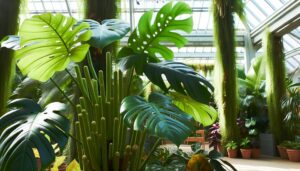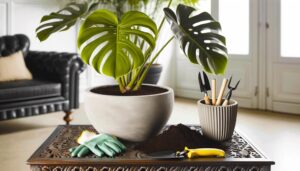Monstera Albo Borsigiana Vs Deliciosa: Key Differences!
When comparing Monstera Albo Borsigiana and Monstera Deliciosa, you’ll find distinct differences in growth and care. Albo Borsigiana climbs quickly with compact growth and striking white variegation, while Deliciosa spreads more with larger, intricate, heart-shaped leaves.
Both thrive with bright, indirect light and high humidity. Use well-draining soil and mist leaves regularly to mimic rainforest conditions.
Variegated Albo Borsigiana requires consistent light to maintain its patterns. Monitor for pests like spider mites and aphids.
Select the right plant for your space and care preferences could reveal their full potential, unveiling even more fascinating details.
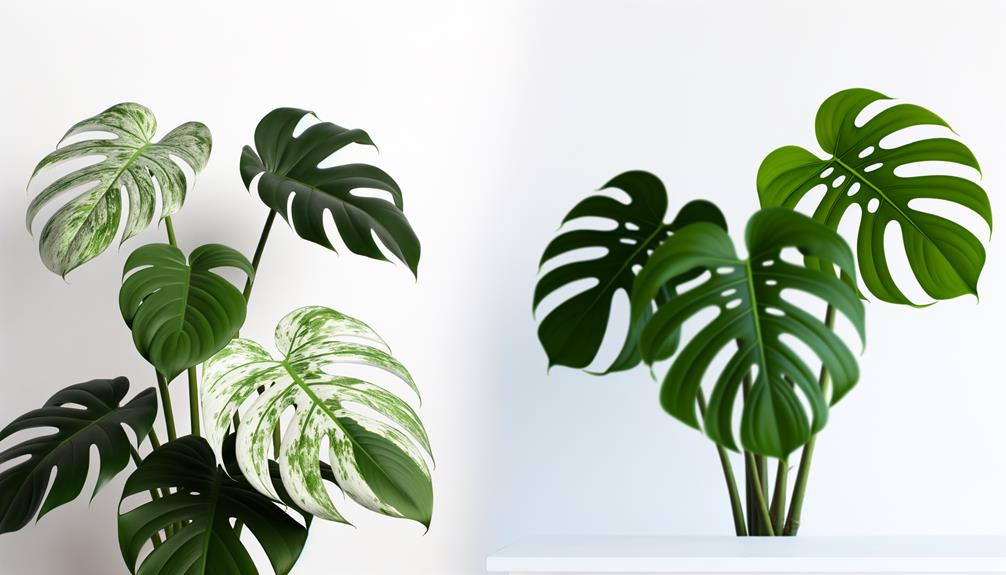
Comparison of Monstera Albo Borsigiana and Monstera Deliciosa
| Feature | Monstera Albo Borsigiana | Monstera Deliciosa |
|---|---|---|
| Leaf Size | Smaller, up to 60cm | Larger, up to 1m |
| Growth Rate | Faster | Slower |
| Internodal Spacing | Larger | Smaller, more compact |
| Stem Thickness | Thinner | Thicker |
| Geniculum (Leaf Joint) | Straight, less pronounced | Wrinkled, more pronounced |
| Fenestrations | Fewer | More numerous |
| Mature Plant Size | Smaller overall | Larger overall |
Origins and Background
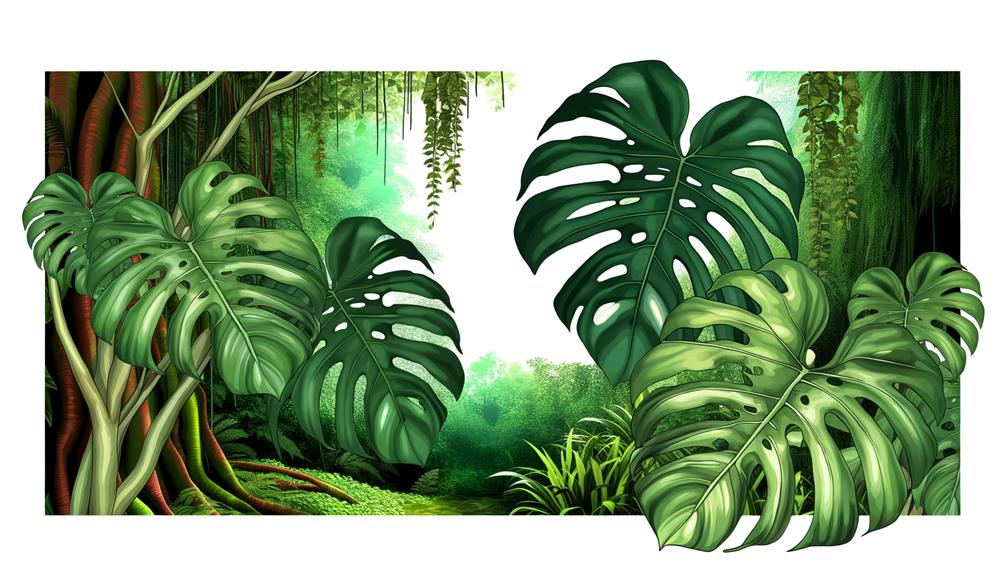
The Monstera Albo Borsigiana and Monstera Deliciosa, both members of the Araceae family, originate from the tropical rainforests of Central and South America. You’ll find that these plants thrive in humid, shaded environments, climbing trees with their aerial roots.
The Albo Borsigiana is a variegated variety of the Monstera, showcasing striking white patches on its leaves. In contrast, the Deliciosa features uniformly green, fenestrated leaves.
To replicate their natural habitat, maintain a warm, humid environment with indirect sunlight. Use well-draining soil, like a mix of peat, perlite, and orchid bark. Regularly mist the leaves to mimic rainforest conditions and support aerial root development.
Growth Patterns
When observing their growth patterns, you’ll notice that Monstera Albo Borsigiana tends to have a more compact and faster climbing habit compared to the Monstera Deliciosa, which grows larger and more spread out.
The Albo Borsigiana’s internodes are shorter, allowing it to climb more efficiently. In contrast, the Deliciosa’s sprawling nature means it requires more space and support.
- Aerial Roots Development: Albo Borsigiana produces robust aerial roots, aiding in faster vertical growth.
- Node Spacing: Deliciosa has wider node spacing, resulting in a more expansive spread.
- Support Needs: Albo Borsigiana benefits from moss poles or trellises, whereas Deliciosa needs larger, sturdier structures.
Understanding these differences helps you cultivate each plant according to its natural tendencies.
Leaf Size and Shape
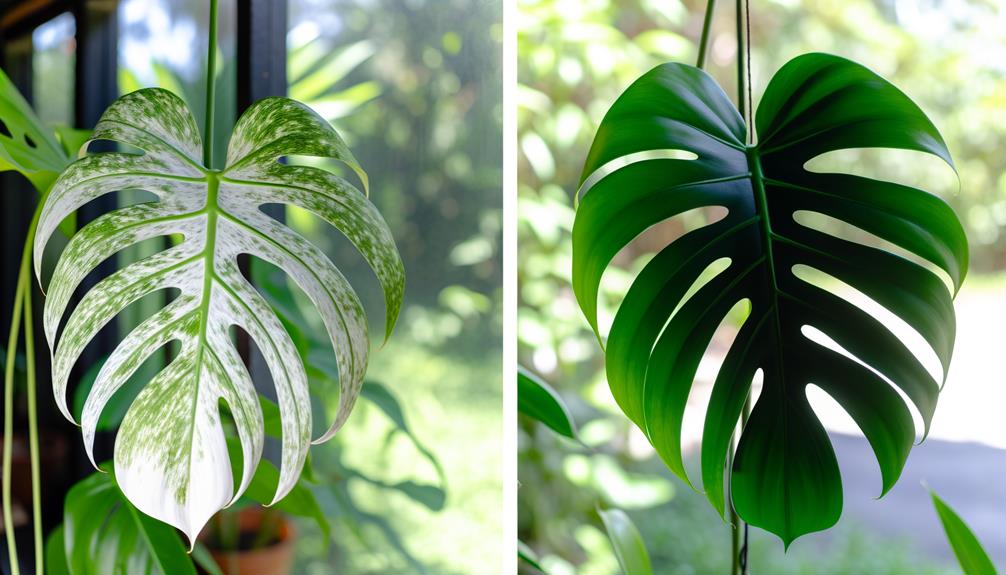
Frequently, you’ll notice that Monstera Albo Borsigiana‘s leaves are typically smaller and more slender compared to the broader, more imposing leaves of Monstera Deliciosa.
The Albo Borsigiana exhibits elongated, lanceolate leaves with more pronounced fenestrations, or natural perforations. These fenestrations allow for better light penetration and air flow, vital in densely vegetated environments.
Conversely, Monstera Deliciosa’s leaves are larger, heart-shaped, and often have a more intricate pattern of splits and holes.
To cultivate either plant successfully, make sure they receive indirect light and maintain high humidity. Regular misting helps mimic their native tropical conditions. Monitor soil moisture to prevent root rot; well-draining soil is essential.
Variegation Differences
Characterized by its striking white or cream patches, Monstera Albo Borsigiana showcases variegation that adds an elegant touch and a unique visual appeal to your plant collection. This variegation is due to a genetic mutation that reduces chlorophyll in certain leaf areas, creating a beautiful contrast.
- Stable variegation patterns: Albo Borsigiana’s variegation remains consistent, unlike the sometimes sporadic patches on Deliciosa.
- Propagation challenges: Maintaining variegation during propagation requires careful selection of variegated nodes.
- Growth rate: Variegated Albo Borsigiana tends to grow slower than its non-variegated counterparts due to reduced chlorophyll.
Understanding these nuances helps you cultivate these plants effectively, ensuring their variegation remains vibrant and healthy.
Light Requirements
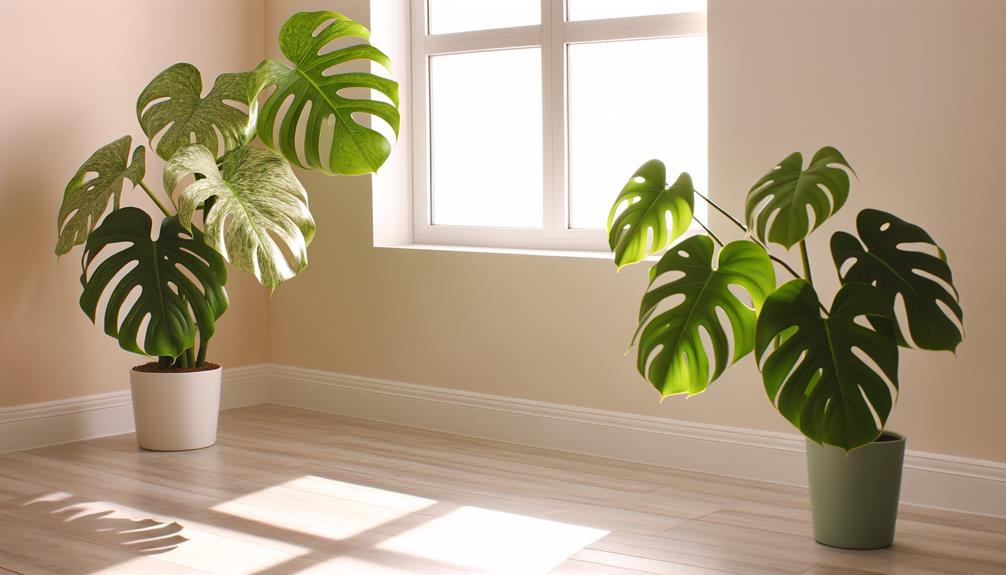
For best growth, you’ll want to provide bright, indirect light for both Monstera Albo Borsigiana and Deliciosa, though the Albo Borsigiana’s variegation requires especially consistent lighting to maintain its striking patterns.
When considering indoor versus outdoor light, positioning near east-facing windows can offer the perfect balance without risking direct sunburn.
Both species tolerate varying light intensities, but prolonged low light can stunt growth and reduce the vibrancy of the foliage.
Optimal Light Conditions
Both Monstera Albo Borsigiana and Monstera Deliciosa thrive best in bright, indirect light, mimicking the dappled sunlight of their natural understory habitat. You’ll want to avoid direct sunlight, which can scorch their leaves, causing unsightly brown spots. Position your Monstera near a north or east-facing window where they can receive gentle morning light.
Key observations for ideal light conditions include:
- Leaf Color: Variegated leaves of Monstera Albo Borsigiana need more light to maintain their striking white patterns.
- Growth Rate: Insufficient light results in leggy growth and smaller leaves, while favorable light promotes larger, fenestrated leaves.
- Leaf Orientation: Monitor leaf orientation; leaves stretching towards the light indicate inadequate lighting.
Using these techniques, you’ll cultivate a healthy, vibrant Monstera.
Indoor Vs. Outdoor Light
When comparing indoor and outdoor light requirements, it’s important to consider how each environment impacts the growth and health of your Monstera Albo Borsigiana and Monstera Deliciosa.
Indoors, place them near a window where they receive bright, indirect light, mimicking the dappled sunlight of their native rainforest understory. Outdoors, place them in a shaded area to prevent leaf scorch from direct sunlight.
Both species benefit from consistent light exposure, but too much direct sun can lead to chlorosis or leaf burn. Use sheer curtains indoors to filter light or position them under taller plants when outside.
Understanding these needs helps you create an ideal light environment, fostering vigorous growth and vibrant foliage.
Light Intensity Tolerance
Understanding the light intensity tolerance of Monstera Albo Borsigiana and Monstera Deliciosa is crucial for optimizing their growth and guaranteeing their foliage maintains its vibrant, variegated patterns. Both species thrive in bright, indirect light but differ slightly in their needs.
- Monstera Albo Borsigiana: Requires more filtered light to prevent leaf burn due to its variegation. It’s sensitive to direct sunlight.
- Monstera Deliciosa: More tolerant of direct light but still prefers bright, indirect sunlight. It can adapt to lower light but grows slower.
- General Tips: Place your Monstera near an east-facing window for morning sun or use sheer curtains to diffuse stronger light. Rotate the plant regularly to guarantee even growth.
Watering Needs
When it comes to watering your Monstera Albo Borsigiana and Deliciosa, you’ll need to monitor soil moisture levels carefully.
Both species prefer their soil to be consistently moist but not waterlogged, ensuring you water them when the top inch of soil feels dry.
Use a well-draining potting mix and avoid letting them sit in standing water to prevent root rot.
Frequency of Watering
In relation to watering needs, Monstera Albo Borsigiana and Monstera Deliciosa both thrive with a consistent watering routine that keeps the soil moist but not waterlogged. You should water these plants when the top inch of soil feels dry to the touch.
- Seasonal adjustments: In the growing season (spring and summer), water more often, while in the dormant season (fall and winter), reduce watering.
- Environmental factors: Consider humidity levels and temperature; higher humidity and warmer temperatures may require more frequent watering.
- Plant size and pot type: Larger plants and those in terracotta pots may dry out faster and need more frequent watering.
Monitoring these factors helps maintain the health and vibrancy of your Monstera Albo Borsigiana and Deliciosa.
Soil Moisture Levels
To promote ideal growth, you should maintain soil moisture at a level where it stays consistently damp but not saturated. Overwatering can lead to root rot, while underwatering can cause wilting and slowed growth. Use your finger to check the top inch of soil; it should feel moist but not soggy.
| Monstera Albo Borsigiana | Monstera Deliciosa |
|---|---|
| Prefers slightly drier soil between waterings | Thrives in consistently moist soil |
| Tolerates occasional drying out | Requires more frequent watering |
| More prone to root rot if overwatered | Can tolerate higher moisture levels |
| Needs well-draining potting mix | Benefits from moisture-retentive mix |
Adjust your watering schedule to accommodate seasonal changes in temperature and humidity. This guarantees your Monstera remains healthy and vibrant year-round.
Soil Preferences
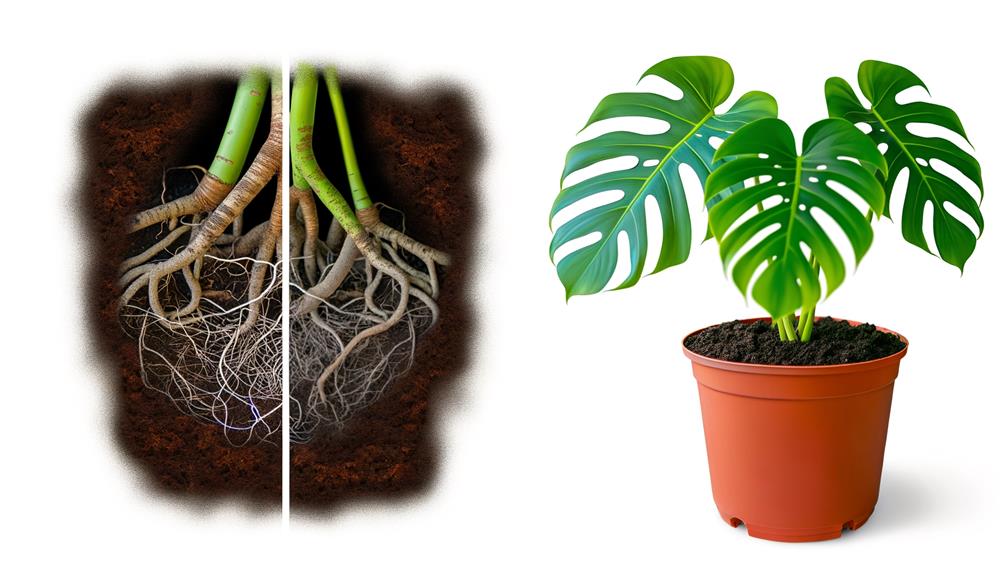
Both Monstera Albo Borsigiana and Deliciosa thrive in well-draining, nutrient-rich soil that mimics their natural tropical environment. To accomplish this, you should use a mix that allows for aeration and retains moisture without becoming waterlogged.
Consider incorporating:
- Orchid bark: Enhances drainage and aeration.
- Perlite: Prevents soil compaction and improves drainage.
- Peat moss: Retains moisture while providing a slightly acidic pH.
When potting, make sure the soil mix includes organic matter to supply essential nutrients. Regularly check the soil’s consistency to prevent root rot and allow for healthy root growth.
Temperature and Humidity
For ideal growth, you should maintain Monstera Albo Borsigiana and Deliciosa within a temperature range of 65-85°F.
Both species thrive in high humidity environments, ideally between 60-80%.
Regular misting or using a humidifier can help you achieve these conditions, promoting robust foliage and healthier plants.
Ideal Temperature Range
Maintaining the ideal temperature and humidity is essential for the healthy growth of Monstera Albo Borsigiana and Deliciosa. Both varieties thrive best in environments where temperatures range between 65-85°F and humidity levels stay above 60%.
This temperature range supports peak cellular functions and photosynthesis, promoting vigorous growth and fenestration development.
Avoid sudden temperature changes, as these can stress the plant and lead to leaf discoloration or stunted growth.
Ensure nighttime temperatures don’t drop below 60°F to prevent chilling injury and slowed metabolic processes.
Create a stable microclimate by placing your Monstera away from drafty windows or heating vents, maintaining consistent warmth.
Prioritizing these factors helps your Monstera reach its maximum potential.
Humidity Requirements
Humidity plays a crucial role in the health and vigor of Monstera Albo Borsigiana and Deliciosa. These tropical plants flourish best in environments where humidity levels consistently stay above 60%. You’ll notice their leaves become more vibrant and glossy under high humidity conditions.
To maintain this, consider using a humidifier, especially during drier months, or place your plants on a humidity tray filled with water and pebbles. Regular misting can also help mimic their natural habitat. However, be cautious of overwatering the soil, as excessive moisture can lead to root rot.
Monitoring with a hygrometer can provide precise humidity readings, ensuring your Monsteras get the best conditions for thriving growth and lush foliage.
Common Pests
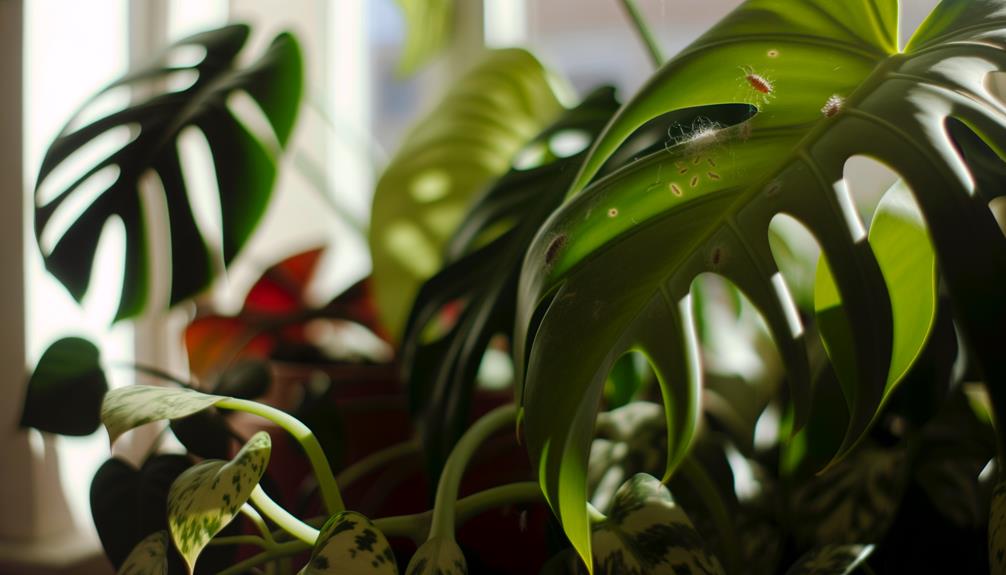
Both Monstera Albo Borsigiana and Deliciosa are susceptible to common pests like spider mites, aphids, and mealybugs, which can cause significant harm if not promptly managed. These pests typically target the plant’s lush foliage, leading to discoloration, stunted growth, and overall decline. To maintain healthy specimens, regular inspection and immediate intervention are important.
- Spider Mites: Look for tiny webbing and yellow speckled leaves. Increase humidity and use miticides if needed.
- Aphids: Check young leaves and stems for clusters of these small insects. A strong water spray or insecticidal soap can help.
- Mealybugs: Identify these pests by their cotton-like appearance on stems and leaf nodes. Use rubbing alcohol on a cotton swab to remove them.
Regular monitoring guarantees prompt action against these common pests.
Propagation Techniques
Propagating Monstera Albo Borsigiana and Deliciosa typically involves stem cuttings, making sure each cutting includes at least one node and an aerial root for optimal growth. Begin by using sterilized pruning shears to make clean cuts just beneath a node. Place the cuttings in water or directly into a well-draining potting mix. For water propagation, change the water every few days to prevent stagnation.
Here’s a quick guide:
| Step | Technique | Notes |
|---|---|---|
| Cutting | Beneath node | Ensure one node, aerial root |
| Water Prop. | Change water | Every few days |
| Soil Prop. | Well-draining mix | Keep moist but not soggy |
Monitor for root development and transplant once roots are established.
Price and Availability

When considering the price and availability of Monstera Albo Borsigiana and Deliciosa, you’ll notice a significant difference influenced by their rarity and market demand.
Monstera Albo Borsigiana, with its striking variegation, tends to be rarer and hence more expensive. This scarcity arises from the plant’s slower growth rate and challenging propagation process.
In contrast, Monstera Deliciosa is more readily available and affordable due to its robust growth and ease of cultivation.
Understanding these factors will help you make an informed decision on which Monstera to add to your collection.
Conclusion
To sum it up, choosing between Monstera Albo Borsigiana and Deliciosa comes down to your specific preferences and growing conditions. The Albo’s eye-catching variegation and compact growth may capture your interest, but the Deliciosa’s bigger leaves and sturdy nature have their own appeal.
Both need comparable care: ample, indirect sunlight, warm temperatures, and high humidity levels. Watch out for pests and follow correct propagation methods.
Essentially, they’re like two peas in a pod, each adding distinctive beauty to your living area.


